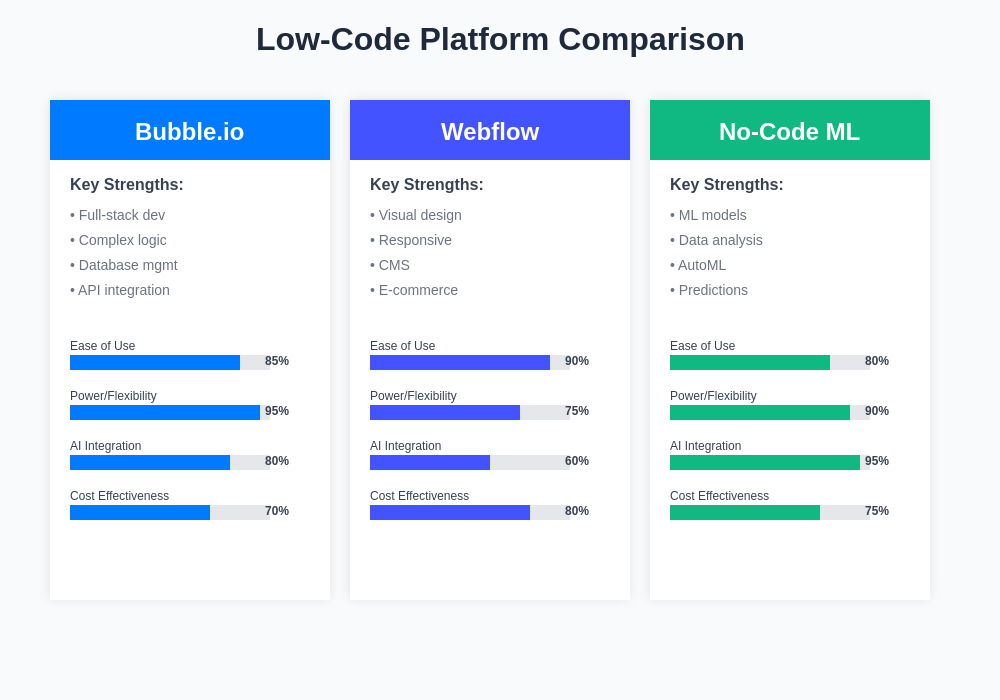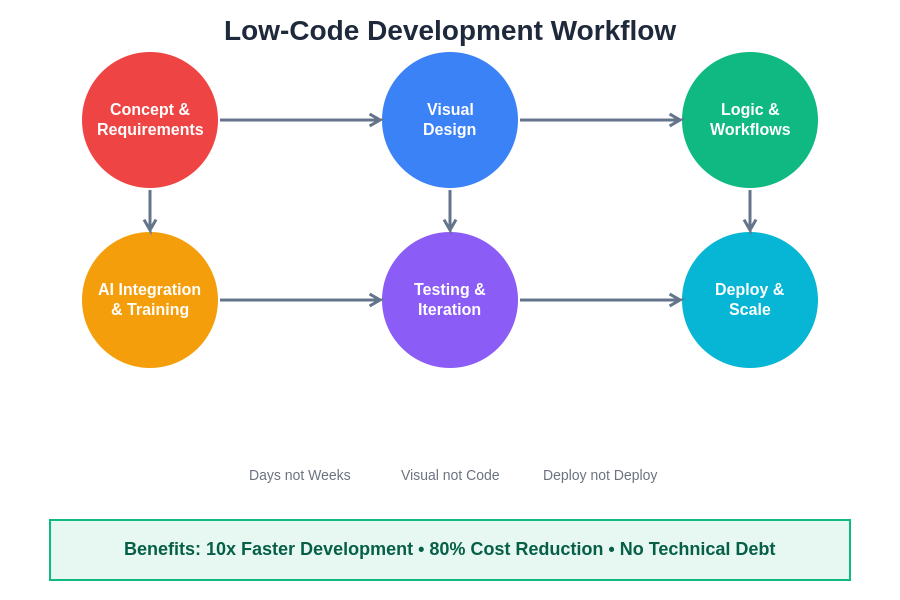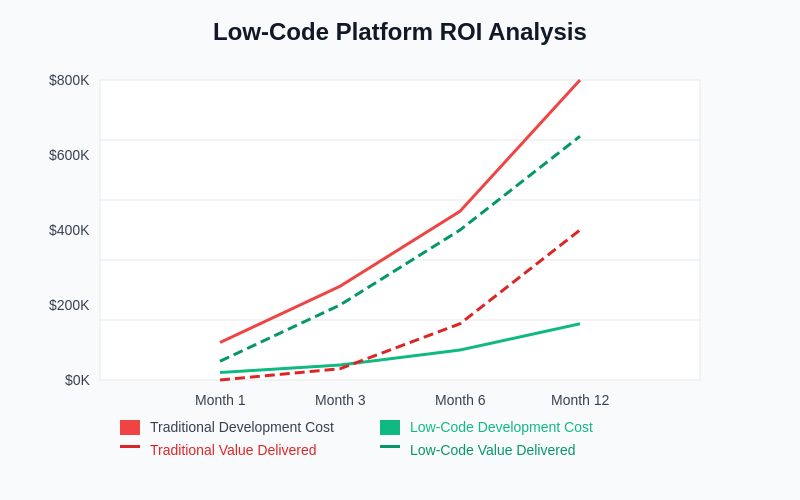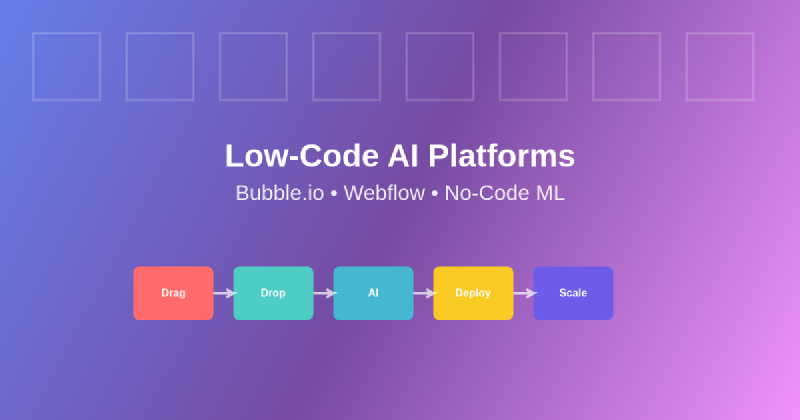The technological landscape has witnessed a revolutionary transformation with the emergence of low-code and no-code artificial intelligence platforms that are fundamentally reshaping how applications are conceived, developed, and deployed. These innovative solutions have democratized the development process by enabling individuals without extensive programming backgrounds to create sophisticated applications, integrate complex AI functionalities, and deploy machine learning models through intuitive visual interfaces and drag-and-drop mechanisms.
Stay updated with the latest AI platform developments as the no-code revolution continues to accelerate, bringing enterprise-level capabilities to creators, entrepreneurs, and businesses of all sizes. The convergence of artificial intelligence with low-code platforms represents a paradigmatic shift that is eliminating traditional barriers to entry in software development while simultaneously expanding the possibilities for innovation and creativity.
The Rise of Visual Development Paradigms
The evolution from traditional coding methodologies to visual development platforms represents one of the most significant shifts in software development since the advent of high-level programming languages. Low-code AI platforms have emerged as powerful solutions that combine the sophistication of artificial intelligence with the accessibility of visual programming interfaces, creating an environment where complex applications can be built through intuitive drag-and-drop operations rather than extensive code writing.
This transformation has been particularly impactful in addressing the global shortage of skilled developers while simultaneously enabling domain experts who possess deep business knowledge but limited programming skills to create sophisticated applications. The visual development paradigm leverages graphical user interfaces, pre-built components, and automated code generation to streamline the development process, reducing time-to-market and lowering the technical barriers that have traditionally prevented non-programmers from participating in application development.
The integration of artificial intelligence capabilities into these platforms has further amplified their potential, enabling users to incorporate machine learning models, natural language processing, computer vision, and predictive analytics into their applications without requiring deep understanding of the underlying algorithmic complexities. This democratization of AI technology has opened new possibilities for innovation across industries and use cases that were previously inaccessible to organizations lacking extensive technical resources.

The landscape of low-code AI platforms presents distinct advantages and specializations, with each platform excelling in different aspects of the development process. Understanding these comparative strengths enables organizations to select the most appropriate platform for their specific use cases and requirements.
Bubble.io: Revolutionizing Web Application Development
Bubble.io stands as one of the most comprehensive and powerful low-code platforms available today, offering users the ability to create fully functional web applications with sophisticated backend logic, database management, and user interface design without writing a single line of code. The platform’s visual programming environment enables users to define workflows, create database structures, design responsive user interfaces, and integrate third-party services through an intuitive drag-and-drop interface that abstracts away the complexities of traditional web development.
The artificial intelligence capabilities integrated into Bubble.io extend far beyond simple automation, encompassing advanced features such as intelligent data processing, automated workflow optimization, and AI-powered user experience enhancements. Users can leverage machine learning APIs to incorporate natural language processing, image recognition, sentiment analysis, and predictive modeling into their applications, creating sophisticated solutions that rival those built by traditional development teams.
Experience advanced AI development with Claude to complement your low-code development with powerful reasoning and analysis capabilities that enhance the planning and optimization phases of your projects. The combination of visual development platforms and AI assistants creates a comprehensive development ecosystem that maximizes both efficiency and capability.
The platform’s database management system provides users with the ability to create complex relational databases, define custom data types, implement security protocols, and establish data validation rules through visual interfaces that eliminate the need for SQL knowledge or database administration expertise. This approach has enabled non-technical entrepreneurs, business analysts, and domain experts to create data-driven applications that would have previously required extensive technical teams and significant development resources.
Bubble.io’s workflow system represents perhaps its most powerful feature, enabling users to create complex business logic through visual flowcharts that define how applications respond to user interactions, process data, integrate with external services, and execute automated tasks. These workflows can incorporate conditional logic, loops, data transformations, and API integrations, providing the flexibility and functionality needed to create enterprise-level applications while maintaining the accessibility that defines the low-code approach.
Webflow: Bridging Design and Development
Webflow has established itself as a revolutionary platform that bridges the gap between visual design and functional web development, enabling designers and creative professionals to create responsive websites and web applications without the traditional constraints of static design tools or the complexity of conventional coding approaches. The platform combines the creative freedom of design software with the functionality of development frameworks, creating an environment where visual creativity seamlessly translates into functional web experiences.
The artificial intelligence integration within Webflow encompasses both design assistance and development optimization, providing users with intelligent suggestions for layout improvements, responsive design adaptations, and performance optimizations. The platform’s AI capabilities extend to content management, SEO optimization, and user experience analytics, enabling users to create websites that not only look exceptional but also perform optimally across different devices and user contexts.
Webflow’s approach to database integration and dynamic content management has revolutionized how designers and content creators approach web development projects that require sophisticated backend functionality. The platform’s Content Management System enables users to create custom content structures, define relationships between different content types, and implement dynamic page generation without requiring knowledge of server-side programming or database management.
The platform’s e-commerce capabilities demonstrate how low-code solutions can incorporate complex business logic and integrate with external services while maintaining the visual approach that makes the platform accessible to non-technical users. Users can create sophisticated online stores with custom product catalogs, inventory management, payment processing, and customer relationship management features through visual interfaces that abstract away the underlying technical complexities.
No-Code Machine Learning Revolution
The emergence of no-code machine learning platforms represents perhaps the most significant democratization of artificial intelligence technology since the development of machine learning itself. These platforms have transformed machine learning from a highly specialized field requiring extensive mathematical knowledge and programming expertise into an accessible toolkit that domain experts, business analysts, and creative professionals can leverage to solve complex problems and generate valuable insights.
No-code ML platforms typically provide users with intuitive interfaces for data preparation, model training, evaluation, and deployment, abstracting away the mathematical complexities while maintaining the power and flexibility needed for sophisticated machine learning applications. Users can upload datasets, select from pre-configured algorithms, adjust parameters through visual controls, and deploy trained models to production environments without writing code or managing infrastructure.
Enhance your research capabilities with Perplexity to gather comprehensive information about emerging no-code ML platforms and stay current with the rapidly evolving landscape of accessible artificial intelligence tools. The combination of multiple AI-powered research and development tools creates a comprehensive ecosystem for no-code innovation.
The impact of no-code machine learning extends across numerous industries and use cases, from predictive analytics in retail and finance to computer vision applications in manufacturing and healthcare. Small businesses can now leverage sophisticated demand forecasting models, content creators can implement automated image classification systems, and researchers can deploy complex analytical models without requiring extensive technical teams or infrastructure investments.
The integration of automated machine learning (AutoML) capabilities into no-code platforms has further enhanced their accessibility and effectiveness. These systems can automatically select appropriate algorithms, optimize hyperparameters, and evaluate model performance, enabling users to achieve professional-level results without deep understanding of machine learning theory or methodology.
Platform Integration and Ecosystem Development
The true power of low-code AI platforms emerges through their integration capabilities and ecosystem development, enabling users to create comprehensive solutions that leverage multiple platforms, services, and data sources. Modern low-code platforms provide extensive API integration capabilities, webhook support, and third-party service connections that enable sophisticated application architectures while maintaining the visual development approach that defines the low-code paradigm.
Integration between platforms like Bubble.io and Webflow demonstrates how different low-code solutions can complement each other, with Webflow handling front-end design and content management while Bubble.io manages backend logic and database operations. This multi-platform approach enables teams to leverage the strengths of different tools while maintaining consistency and functionality across their complete application stack.
The ecosystem surrounding low-code AI platforms has grown to include specialized components, templates, plugins, and integration services that extend platform capabilities and accelerate development processes. Marketplaces for pre-built components enable users to incorporate sophisticated functionality into their applications without building everything from scratch, while community-contributed resources provide learning materials, best practices, and collaborative development opportunities.

The streamlined development workflow enabled by low-code platforms represents a fundamental shift from traditional development methodologies, emphasizing rapid iteration, visual design, and immediate deployment capabilities that dramatically reduce time-to-market while maintaining professional-level functionality and scalability.
Business Impact and ROI Considerations
Organizations adopting low-code AI platforms consistently report significant improvements in development speed, cost efficiency, and innovation capacity compared to traditional development approaches. The ability to rapidly prototype, iterate, and deploy applications enables businesses to respond more quickly to market opportunities, test new concepts with minimal resource investment, and adapt their technology solutions as business requirements evolve.
The democratization aspect of low-code platforms has proven particularly valuable for organizations seeking to leverage domain expertise in application development. Subject matter experts who understand business processes, customer needs, and industry requirements can now directly participate in solution development rather than relying on technical intermediaries who may lack domain knowledge. This direct involvement often results in applications that better address real-world requirements and user needs.
Cost considerations extend beyond immediate development expenses to include long-term maintenance, scaling, and adaptation costs. Low-code platforms typically provide automatic updates, infrastructure management, and scaling capabilities that reduce ongoing operational overhead while ensuring applications remain current with evolving security standards and performance requirements. The visual nature of low-code development also facilitates knowledge transfer and reduces dependency on specific individuals or technical expertise.

The return on investment analysis consistently demonstrates the substantial advantages of low-code development approaches, with organizations experiencing significantly faster value delivery, reduced development costs, and improved project success rates compared to traditional development methodologies.
Security and Compliance in Low-Code Environments
Security considerations in low-code AI platforms encompass both the inherent security features provided by platform vendors and the security implications of democratized development processes. Leading platforms implement comprehensive security measures including data encryption, access controls, audit logging, and compliance certifications that often exceed the security capabilities that individual organizations could implement independently.
The democratization of development through low-code platforms introduces new security considerations related to governance, oversight, and standardization across organizations. Establishing appropriate guidelines, approval processes, and monitoring systems becomes crucial for ensuring that applications developed through low-code platforms maintain appropriate security standards while preserving the agility and innovation benefits that drive platform adoption.
Compliance with industry regulations and data protection requirements represents another critical consideration for organizations leveraging low-code AI platforms. Leading platforms provide built-in compliance features, data governance tools, and privacy controls that help organizations meet regulatory requirements while maintaining the flexibility and efficiency that characterize low-code development approaches.
Performance Optimization and Scalability
Performance considerations in low-code AI platforms involve balancing the ease of development with the efficiency and scalability requirements of production applications. Modern platforms implement sophisticated optimization techniques including automatic code generation, caching mechanisms, and infrastructure scaling that ensure applications built through visual interfaces can achieve performance levels comparable to traditionally developed solutions.
Scalability planning in low-code environments requires understanding both platform limitations and optimization opportunities. While low-code platforms handle much of the underlying infrastructure complexity, successful scaling often requires strategic architectural decisions, data optimization, and integration planning that consider both current requirements and future growth projections.
The integration of AI capabilities adds additional performance considerations related to model inference, data processing, and resource utilization. Low-code platforms typically provide optimization tools and monitoring capabilities that help users understand and improve the performance of their AI-enhanced applications while maintaining the visual development approach that defines the platform experience.
Future Trends and Evolution
The future evolution of low-code AI platforms points toward even greater sophistication in artificial intelligence integration, expanded ecosystem development, and enhanced collaboration capabilities. Emerging trends include natural language programming interfaces that enable application development through conversational interactions, advanced AI assistants that provide intelligent development guidance, and automated optimization systems that continuously improve application performance and user experience.
The convergence of low-code platforms with emerging technologies such as augmented reality, Internet of Things, and blockchain represents significant opportunities for expanding the scope and impact of visual development approaches. These integrations promise to make cutting-edge technologies accessible to broader audiences while maintaining the ease-of-use characteristics that define successful low-code platforms.
Industry consolidation and platform maturation are likely to result in more comprehensive solutions that integrate design, development, deployment, and maintenance capabilities into unified platforms. This evolution will further reduce the complexity and resource requirements for creating sophisticated applications while expanding the possibilities for innovation and creativity across diverse industries and use cases.
The continued advancement of artificial intelligence capabilities will likely result in platforms that provide increasingly sophisticated assistance throughout the development lifecycle, from initial concept development through deployment and maintenance. These AI-enhanced platforms may eventually enable natural language specification of application requirements that are automatically translated into functional implementations, representing the ultimate realization of the low-code vision.
Conclusion
Low-code AI platforms represent a fundamental shift in how applications are conceived, developed, and deployed, democratizing access to sophisticated technology capabilities while maintaining the power and flexibility needed for complex business solutions. Platforms like Bubble.io, Webflow, and various no-code ML solutions have proven that visual development approaches can deliver professional-level results while significantly reducing the time, cost, and expertise requirements traditionally associated with application development.
The integration of artificial intelligence capabilities into these platforms has amplified their potential, enabling users to create applications that incorporate machine learning, natural language processing, and other advanced AI functionalities without requiring deep technical expertise. This democratization of AI technology has opened new possibilities for innovation across industries and use cases while addressing the global shortage of skilled developers.
As these platforms continue to evolve and mature, they promise to further reduce the barriers between business vision and technical implementation, enabling more organizations and individuals to participate in the digital transformation that is reshaping industries and creating new opportunities for growth and innovation. The future of application development increasingly points toward collaborative ecosystems where human creativity and artificial intelligence work together to create solutions that would be impossible through either approach alone.
Disclaimer
This article is for informational purposes only and does not constitute professional advice regarding platform selection, development strategies, or technology implementation. The views expressed are based on current understanding of low-code and no-code development platforms. Readers should conduct thorough research and consider their specific requirements, security needs, and scalability goals when evaluating low-code AI platforms. Platform capabilities, pricing, and features may vary and change over time.
